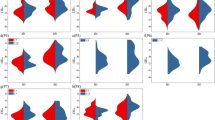Summary
In the Institute for Potato Research, Groß Lüsewitz, a collection of wild and cultivated potato species of different valence levels is preserved in living state. Chiefly the preservation of the collection is done by seeds.
By pollination of tetraploid varieties and promise clones with pollen ofSolanum phureja a collection of dihaploids was produced. This makes it easier to utilize the gene reservoirs of the 24 chromosome wild forms for the creation of basic material. Useful gene combination can be created by intra- and interspecific hybridisation provided that the dihaploid genotypes show efficient blossom intensity and pollen fertility. To increase the yield of diplogametic tetraploids for the genetic breedings it has to be searched for genotypes in the dihaploid collection that have a higher frequency of diplogametes.
Zusammenfassung
Im Institut für Kartoffelforschung Groß Lüsewitz wird ein lebendes Sortiment von Wild- und Kulturkartoffeln verschiedener Valenzstufen erhalten. Die Sortimentserhaltung geschieht hauptsächlich durch Samenvermehrung. Durch Bestäubung von tetraploiden Sorten und von aussichtsreichen Klonen mit Pollen vonSolanum phureja wurde ein Sortiment von Dihaploiden erzeugt. Dadurch wird es leichter möglich, das Genreservoir der 24chromosomigen Wildformen zur Entwicklung von Ausgangsmaterial zu nutzen. Eine brauchbare Genkombination kann durch intra- und interspezifische Hybridisierung erreicht werden, vorausgesetzt, daß die dihaploiden Genotypen ausreichend blühen und hohe Pollenfertilität besitzen. Um die Ausbeute an diplogametischen Tetraploiden für züchterische Zwecke zu erhöhen, muß im dihaploiden Sortimentsmaterial nach Genotypen gesucht werden, bei denen Diplogameten häufiger auftreten.
Краткое содержание
В н.-и. институте картоф еля в Грос-Люзевице со храняется живая коллекция дикорастущих и культ урных форм картофеля различных степеней плоидии. Коллекция сохраняет ся, главным образом пу тëм размножения семян. Оп ылением тетраплоидных сорто в и перспективных кло нов пыльцой Solanum phureja был создан сортимен т дигаплоидных расте ний. С их помощью можно будет облегчить испо льзование генофонда 24-хромосомных дикорас тущих форм для получения ис ходного материала. По дходящая комбинация генов может быть получена п утëм видовой и внутри видовой гибридизаций в том случае, если дигаплои дные генотипы будут х орошо цвести и обладать выс окой фертильностью пыльц ы. Чтобы для селекцион ных целей повысить выход диплогаметных тетра плоидов, надо в сортим енте дигаплоидов найти та кие генотипы, у которых бу дет чаще наблюдаться образование диплога мет.
Similar content being viewed by others
Literature
Hinze, E. 1976: Untersuchungen über die rationelle Erhaltung eines Sortiments wilder und kultivierter Kartoffelspecies. - (Report.) Groß Lüsewitz.
—,H. Ludwig andW. Junges, 1978: Das Keimverhalten von Kartoffelsamen nach 8jähriger Lagerung unter verschiedenen Bedingungen. - Arch. Züchtungsforsch., Berlin,8, 205–209.
Hougas, R. W., andS. J. Peloquin, 1958: The potential of potato haploids in breeding and genetic research. - Am. potato J.35, 701–707.
Pett, B., 1974: Untersuchungen zur Meristemkultur bei Kartoffeln. - Arch. Phytopathol. und Pflanzenschutz, Berlin,10, 81–88.
Rothacker, D., 1966: Sortiment wilder und kultivierter Kartoffelspecies des Instituts für Pflanzenzüchtung Groß Lü sewitz (G-LKS), Teil 1. - Groß Lüsewitz.
-, 1968: Sortiment wilder und kultivierter Kartoffelspecies des Instituts für Pflanzenzüchtung Groß Lüsewitz (G-LKS), Teil 2. - Groß Lüsewitz.
Rybin, V. A., 1933: Cytological investigation of the South American cultivated and wild potatoes and its significance for plant breeding (Russ.). - Trud. priklad. Bot. Genet. Selekc., ser. II.2, 3–100.
Schreiter, J., andH. Tiemann, 1977: Die Prüfung des Pollenschlauchwachstums in vivo bei Dihaploiden vonSolanum tuberosum L. - Arch. Züchtungsforsch., Berlin,7, 253–258.
Tiemann, H., 1976: Einige Aspekte zur Herstellung, Auslese und Verwendung Dihaploider in der Kartoffelzüchtung. - Biol. Rdsch.14, 73–77.
—, andJ. Schreiter, 1976: Zur Blühintensität und Blütenbiologie bei Dihaploiden vonSolanum tuberosum L. - Biol. Zbl.95, 579–588.
Author information
Authors and Affiliations
Rights and permissions
About this article
Cite this article
Tiemann, H. Preservation of gene resources of potato species of different ploidy levels for the building up of breeding material. Die Kulturpflanze 29, 151–157 (1981). https://doi.org/10.1007/BF02014746
Issue Date:
DOI: https://doi.org/10.1007/BF02014746




